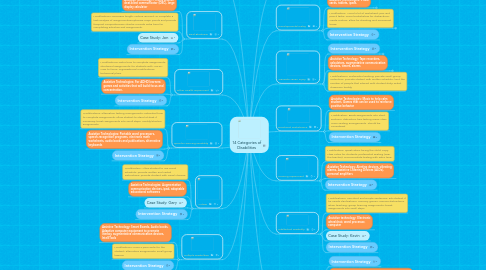14 Categories of Disabilities
by Arianna Jezari


1. Deafness
1.1. Assistive Technology: Vibrating alarms, text messaging, flashing light alerting device,
1.2. Modifications: Extra time to complete assignments, step by step directions, buddy system for notes, use of visual supplements (chalkboard, overhead, charts and lecture outlines), use alternative tests
1.3. Intervention Strategy
2. Deaf-Blindness
2.1. Assistive Technology: Perkins Brailler, deaf-blind communicator (DBC), large display calculator
2.2. Modifications: Decrease length, reduce amount, or complete a task analysis of assignments,Emphasize major points and provide frequent comprehension checks, Provide extra time for completing activities and assignments.
2.3. Case Study: Jon
2.4. Intervention Strategy
3. Other Health Impairment
3.1. Modifications: Extra time to complete assignments, shortened assignments, for students with ADHD: cues to focus, organizational modifications behavioral plans
3.2. Assistive Technologies: For ADHD learners: games and activities that will build focus and concentration.
3.3. Intervention Strategy
4. Specific Learning Disability
4.1. Modifications: alternative testing arrangements, extended time to complete assignments, allow student to stand at desk if necessary, break assignments into small steps, modify/shorten assignments.
4.2. Assistive Technologies: Portable word processors, speech-recognition programs, electronic math worksheets, audio books and publications, alternative keyboards
4.3. Intervention Strategy
5. Autism
5.1. Modification: Allow student to use visual schedule, provide written and verbal instructions, provide student with visual choices,
5.2. Assistive Technologies: Augmentative communication devices, ipad, adaptable educational softwares
5.3. Case Study: Gary
5.4. Intervention Strategy
6. Multiple Disabilities
6.1. Assistive Technology: Smart Boards, Audio books, Adaptive computer equipment to promote literacy, augmentative communication devices, IntelliTools
6.2. Modifications: Have a peer write for the student, alternative assignments, small group lessons
6.3. Intervention Strategy
7. Orthopedic Impairment
7.1. Assistive Technology: Augmentative communication devices, screen reading software, speech recognition software,
7.2. Modification: Seating arrangements to develop useful posture and movements, Instruction that is focused on development of gross and fine motor skills, Ensuring suitable augmentative communication and other assistive devices Adequate awareness of the student’s medical condition and its affect on the student
7.3. Intervention Strategy
8. Visual Impairment (Including Blindness)
8.1. Intervention Strategy
8.2. Assistive Technology: Enlarged images, books on tapes, Braille keyboard, on screen text reader.
8.3. Modification: Reduced assignments, altering assignments to make them easier, providing hints or clues to assignments.
9. Developmental Delay
9.1. Assistive Technologies: Visual cards, tablets, ipads.
9.1.1. Schedule
9.1.2. Budget
9.2. Modification: Avoid a lot of worksheet, pen and pencil tasks, cover bookshelves for distractions, create routine, allow for standing and movement times,
9.2.1. KPI's
9.3. Intervention Strategy
10. Traumatic Brain Injury
10.1. Intervention Strategy
10.1.1. Project specifications
10.1.2. End User requirements
10.1.3. Action points sign-off
10.2. Assistive Technology: Tape recorders, calculators, augmentative communication devices, timers, alarms
10.2.1. Define actions as necessary
